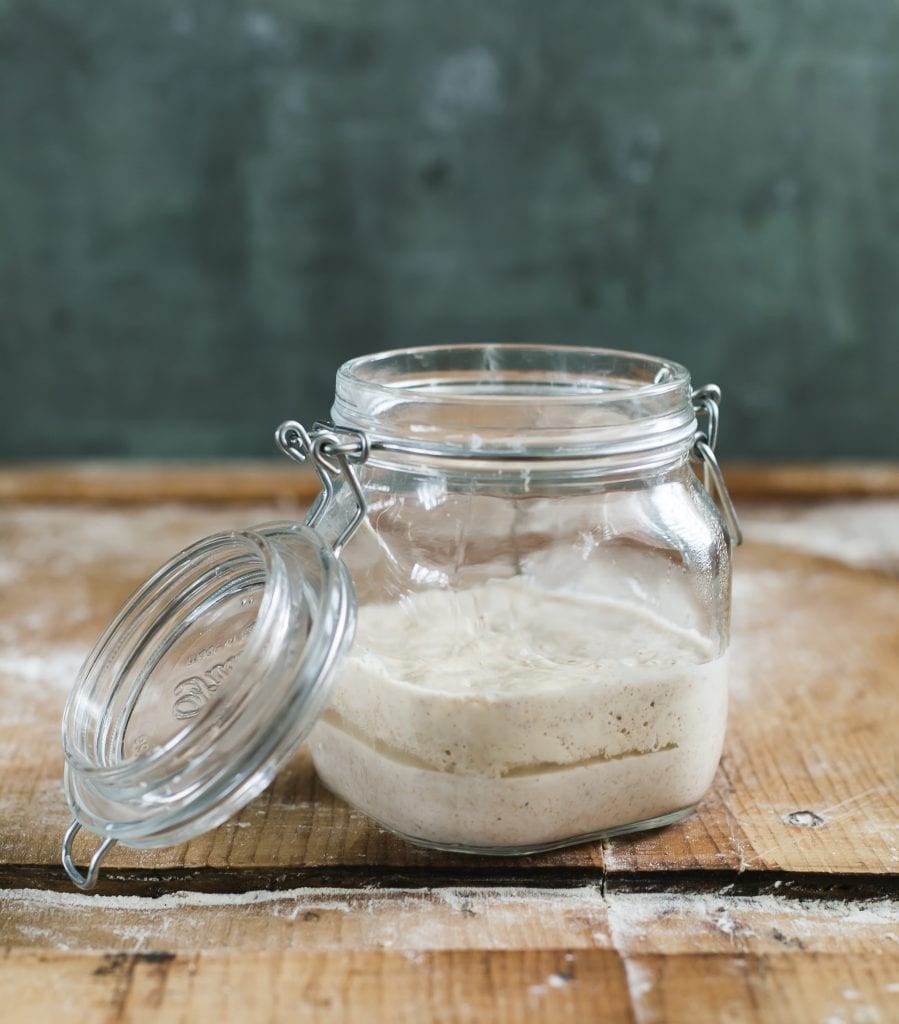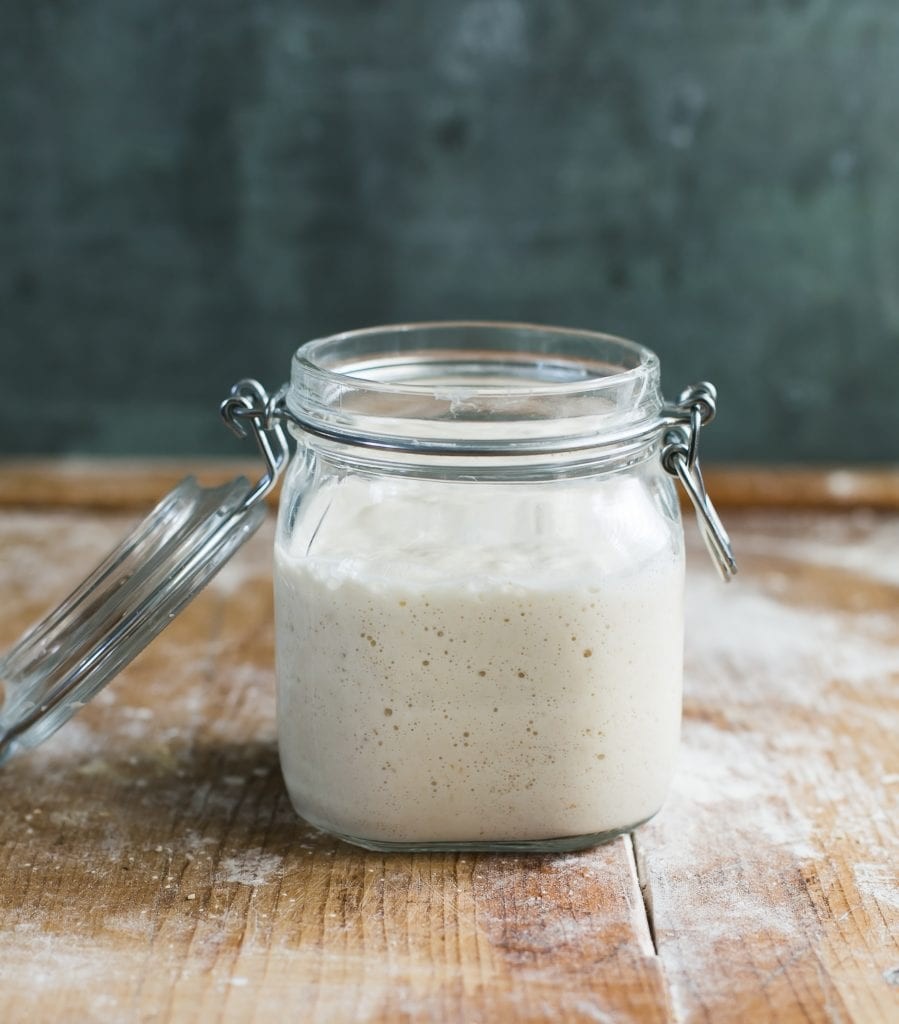What Is Sourdough Starter? It’s the secret to delicious, naturally leavened bread and other baked goods. At WHAT.EDU.VN, we’ll guide you through understanding sourdough starter, its purpose, and how to create one at home. Discover the magic of wild yeast and unlock a world of flavorful sourdough creations. Learn about fermentation, baking, and the best bread recipes.
1. What Is Sourdough Starter?
A sourdough starter is a living culture of flour and water that ferments over time, cultivating wild yeasts and beneficial bacteria. It’s the heart of sourdough baking, providing the leavening power and distinctive tangy flavor that sets sourdough apart from other breads. Unlike commercially produced yeast, sourdough starter relies on naturally occurring microorganisms to make your dough rise.
- It’s a simple mixture of flour and water.
- It’s a living ecosystem of wild yeasts and bacteria.
- It’s the leavening agent in sourdough bread.
- It gives sourdough its unique flavor.
2. Why Use Sourdough Starter?
Using sourdough starter offers several benefits over commercial yeast:
- Flavor: Sourdough starter produces a complex, tangy flavor that commercial yeast can’t replicate. The fermentation process creates a variety of organic acids and aromatic compounds that contribute to the unique taste of sourdough bread.
- Texture: Sourdough bread often has a chewier, more open crumb than bread made with commercial yeast. The slow fermentation process allows the gluten to develop fully, resulting in a more satisfying texture.
- Digestibility: The fermentation process in sourdough breaks down some of the complex carbohydrates in flour, making it easier to digest. Some people find sourdough bread easier to tolerate than bread made with commercial yeast.
- Natural Leavening: Sourdough starter is a natural way to leaven bread, without the need for commercially produced yeast. This appeals to those seeking a more traditional and wholesome approach to baking.
- Shelf Life: Sourdough bread tends to stay fresh longer than bread made with commercial yeast, thanks to the acids produced during fermentation.
3. What Ingredients Do You Need?
Creating a sourdough starter requires only two basic ingredients:
- Flour: Whole wheat flour is often recommended for starting a sourdough culture because it contains more nutrients and microorganisms that can kickstart the fermentation process. However, all-purpose flour, bread flour, or even rye flour can also be used.
- Water: Use filtered or tap water that is free of chlorine and other chemicals. The water should be at room temperature.
4. How Do You Make a Sourdough Starter?
Here’s a step-by-step guide to creating your own sourdough starter:
- Day 1: Combine Flour and Water. In a clean jar or container, mix equal parts (by weight) of flour and water. A good starting point is 60g of whole wheat flour and 60g of water.
- Day 2: Rest. Cover the jar loosely with a lid or plastic wrap and let it sit at room temperature (ideally around 70-75°F or 21-24°C) for 24 hours.
- Day 3: Begin Feeding. Discard half of the starter (this is important to prevent it from becoming too large). Then, add equal parts (by weight) of flour and water to the remaining starter. For example, if you have 60g of starter left, add 30g of flour and 30g of water. Mix well.
- Days 4-7 (or Longer): Repeat Feeding. Repeat the discarding and feeding process every 24 hours. You should start to see signs of activity, such as bubbles forming in the starter. The starter may also increase in volume.
- Days 7+: Monitor and Adjust. Continue feeding the starter daily until it consistently doubles in size within 4-8 hours after feeding. This indicates that the starter is active and ready to use for baking.
5. What Should a Healthy Sourdough Starter Look Like?
A healthy, active sourdough starter will exhibit the following characteristics:
- Bubbles: It will be full of bubbles, both large and small, throughout the culture.
- Rise: It will double in size within a few hours after feeding.
- Smell: It will have a pleasant, slightly tangy aroma. It should not smell foul or moldy.
- Texture: It will be light and airy, with a slightly spongy texture.
6. What If My Sourdough Starter Isn’t Growing?
If your sourdough starter isn’t growing, don’t panic. Here are some common reasons and solutions:
- Temperature: The ideal temperature for sourdough starter growth is around 70-75°F (21-24°C). If your kitchen is too cold, the starter may take longer to become active. Try placing it in a warmer spot, such as near a radiator or in an oven with the light on (but turned off).
- Flour: Make sure you are using a good quality flour. Whole wheat flour is often recommended for starting a starter because it contains more nutrients.
- Patience: It can take a week or more for a sourdough starter to become active. Be patient and continue feeding it regularly.
- Water: Make sure your water is free of chlorine and other chemicals, as these can inhibit the growth of the starter.
7. What Is “Hooch” and What Does It Mean?
“Hooch” is a liquid that sometimes forms on the surface of a sourdough starter. It is a byproduct of fermentation and is essentially alcohol. The presence of hooch indicates that the starter is hungry and needs to be fed.
- Is it normal? Yes, it’s a normal part of the sourdough starter process.
- What do I do? You can either pour off the hooch before feeding the starter, or mix it back in. The hooch can have a strong, unpleasant smell and taste, so many bakers prefer to discard it.
8. How Do I Store My Sourdough Starter?
Once your sourdough starter is active and ready to use, you can store it in one of two ways:
- Room Temperature: If you bake frequently (several times a week), you can store your starter at room temperature. Feed it daily or every other day to keep it active.
- Refrigerator: If you don’t bake as often, you can store your starter in the refrigerator. This will slow down the fermentation process. Feed it once a week to maintain its viability. When you’re ready to bake, take the starter out of the refrigerator and feed it at room temperature for a day or two to revive it.
9. How Do I Know When My Sourdough Starter Is Ready to Use?
Your sourdough starter is ready to use when it consistently doubles in size within 4-8 hours after feeding. It should be full of bubbles and have a pleasant, slightly tangy aroma. To test its readiness, you can perform the “float test”:
- Take a spoonful of starter and drop it into a glass of water.
- If the starter floats, it’s ready to use.
- If it sinks, it needs more time to develop. Continue feeding it regularly until it passes the float test.
10. What Can I Make With Sourdough Starter?
Once you have an active sourdough starter, the possibilities are endless. Here are just a few ideas:
- Sourdough Bread: The classic sourdough loaf is the ultimate expression of sourdough baking.
- Sourdough Pizza Crust: Add a tangy twist to your homemade pizza.
- Sourdough Pancakes: Enjoy a light and fluffy breakfast with a hint of sourdough flavor.
- Sourdough Crackers: Bake up a batch of crispy, flavorful crackers for snacking.
- Sourdough Discard Recipes: Don’t throw away your sourdough discard. Use it to make cookies, muffins, waffles, and more.
11. Troubleshooting Sourdough Starter Problems
Here are some common sourdough starter problems and how to fix them:
| Problem | Possible Cause(s) | Solution(s) |
|---|---|---|
| Starter isn’t rising | Temperature too cold, flour quality poor, starter not yet established | Move starter to a warmer location (70-75°F), try a different flour (whole wheat is often best for starting), be patient and continue feeding regularly. |
| Starter smells foul | Undesirable bacteria present, infrequent feedings | Discard most of the starter and begin feeding more frequently (every 12-24 hours), ensure a clean jar and utensils. |
| Starter has a layer of liquid (hooch) | Starter is hungry, hasn’t been fed recently | Pour off (or mix in) the hooch, then feed the starter with fresh flour and water. |
| Mold is growing on the starter | Contamination, unsanitary conditions | Discard the entire starter and begin again with a clean jar and fresh flour. Ensure all utensils are clean. |
| Starter is too thick | Not enough water | Add a small amount of water during the next feeding until the consistency is like thick pancake batter. |
| Starter is too thin | Too much water | Add a small amount of flour during the next feeding until the consistency is like thick pancake batter. |
| Starter isn’t bubbly enough | Starter is still developing, temperature too cold, not enough food (infrequent feedings) | Give it more time and continue feeding regularly (every 12-24 hours), move to a warmer location (70-75°F). |
| Starter growth slows down after Day 3-4 | Switching from whole wheat flour to all-purpose flour | This is normal as the starter adjusts to the new flour. Continue feeding regularly with all-purpose or bread flour; the starter will re-establish its growth. |




12. Frequently Asked Questions About Sourdough Starter
| Question | Answer |
|---|---|
| Can I use different types of flour for my starter? | Yes, you can use different types of flour, such as whole wheat, rye, or bread flour. Each type of flour will impart a slightly different flavor and texture to the starter. |
| How often should I feed my sourdough starter? | If you store your starter at room temperature, feed it daily or every other day. If you store it in the refrigerator, feed it once a week. |
| Can I freeze my sourdough starter? | Yes, you can freeze your sourdough starter. To thaw, simply take it out of the freezer and let it thaw at room temperature. You may need to feed it a few times to revive it. |
| My sourdough starter is very sour. Is that normal? | Yes, a sour aroma is normal for a sourdough starter. The sourness comes from the lactic acid produced during fermentation. |
| Can I make a gluten-free sourdough starter? | Yes, you can make a gluten-free sourdough starter using gluten-free flours such as rice flour, tapioca flour, or sorghum flour. |
| What is sourdough discard and what can I do with it? | Sourdough discard is the portion of starter that you remove before feeding. It can be used in a variety of recipes, such as pancakes, waffles, muffins, and cookies. |
| Is it safe to use a sourdough starter that has mold on it? | No, it is not safe to use a sourdough starter that has mold on it. Mold can produce toxins that are harmful to your health. Discard the starter and start again with a clean jar and fresh flour. |
| Can I revive a dried sourdough starter? | Yes, you can revive a dried sourdough starter. Rehydrate the starter with water and then feed it regularly until it becomes active. |
| How long does a sourdough starter last? | A well-maintained sourdough starter can last indefinitely. Some sourdough starters have been passed down for generations. |
| What’s the best temperature for sourdough starter fermentation? | The ideal temperature is between 70-75°F (21-24°C). |
13. Advanced Sourdough Starter Techniques
Once you’ve mastered the basics of sourdough starter, you can explore some advanced techniques to enhance your baking:
- Varying Hydration: Experiment with different ratios of flour and water to create starters with different consistencies. A higher hydration starter (more water) will ferment faster and produce a more open crumb in your bread.
- Using Different Flours: Explore the use of different flours, such as rye, spelt, or ancient grains, to add unique flavors and textures to your sourdough.
- Maintaining a “Levain”: A levain is a portion of active sourdough starter that is fed separately and used to leaven your bread dough. Maintaining a levain allows you to control the strength and flavor of your sourdough.
- Autolyse: The autolyse technique involves mixing the flour and water in your bread recipe and letting it rest for 20-60 minutes before adding the starter and salt. This allows the flour to fully hydrate and develop gluten, resulting in a more extensible dough.
- Cold Fermentation: Slowing down the fermentation process by refrigerating your dough for an extended period (12-72 hours) can enhance the flavor and complexity of your sourdough bread.
14. The Science Behind Sourdough Starter
Understanding the science behind sourdough starter can help you become a more successful baker. Here are some key concepts:
- Wild Yeasts: Sourdough starter relies on wild yeasts that are naturally present in flour and the environment. These yeasts ferment the sugars in the flour, producing carbon dioxide gas, which leavens the bread.
- Lactic Acid Bacteria: Sourdough starter also contains lactic acid bacteria, which produce lactic acid and other organic acids. These acids contribute to the tangy flavor of sourdough bread and help to inhibit the growth of undesirable bacteria.
- Enzymes: Sourdough starter contains enzymes that break down starches and proteins in the flour. This makes the dough more extensible and easier to digest.
- Fermentation: Fermentation is the process by which microorganisms convert sugars into acids, gases, and other byproducts. In sourdough baking, fermentation is responsible for leavening the bread, developing its flavor, and improving its texture.
15. Common Sourdough Baking Terms
- Starter: The living culture of flour and water used to leaven sourdough bread.
- Levain: A portion of active sourdough starter that is fed separately and used to leaven the bread dough.
- Autolyse: A technique of mixing flour and water and letting it rest before adding the starter and salt.
- Hydration: The ratio of water to flour in a recipe.
- Proofing: The final rise of the dough before baking.
- Scoring: Making cuts on the surface of the dough before baking to control its expansion.
- Crumb: The interior texture of the bread.
- Crust: The outer layer of the bread.
Have more questions about sourdough starters or any other topic? Don’t struggle in silence. At WHAT.EDU.VN, we provide a platform where you can ask any question and receive helpful answers from knowledgeable individuals, completely free of charge.
Are you struggling to find quick, free answers to your burning questions? Do you feel lost in a sea of information, unsure of where to turn for reliable guidance? At WHAT.EDU.VN, we understand your challenges. We believe that everyone deserves access to accurate information and expert advice, without the burden of cost or complexity.
That’s why we’ve created a unique platform where you can ask any question, on any topic, and receive prompt, insightful answers from our community of experts. Whether you’re a student seeking homework help, a professional facing a work-related dilemma, or simply a curious mind eager to explore the world, WHAT.EDU.VN is here to support you.
Here’s how we can help:
- Ask questions for free: No subscription fees, no hidden charges. Just pure, unadulterated knowledge, readily available at your fingertips.
- Get answers fast: Our community of experts is dedicated to providing timely and accurate responses to your questions.
- Connect with knowledgeable individuals: Tap into the collective wisdom of our diverse community, spanning a wide range of fields and expertise.
- Simplify complex topics: We break down complicated concepts into easy-to-understand explanations, making learning accessible to everyone.
Ready to experience the power of free knowledge?
Visit WHAT.EDU.VN today and ask your question. Let us help you find the answers you’re looking for, so you can learn, grow, and thrive. We’re here to empower you with the information you need to succeed.
Don’t hesitate. Your questions are waiting to be answered!
Contact us at:
Address: 888 Question City Plaza, Seattle, WA 98101, United States
Whatsapp: +1 (206) 555-7890
Website: what.edu.vn
